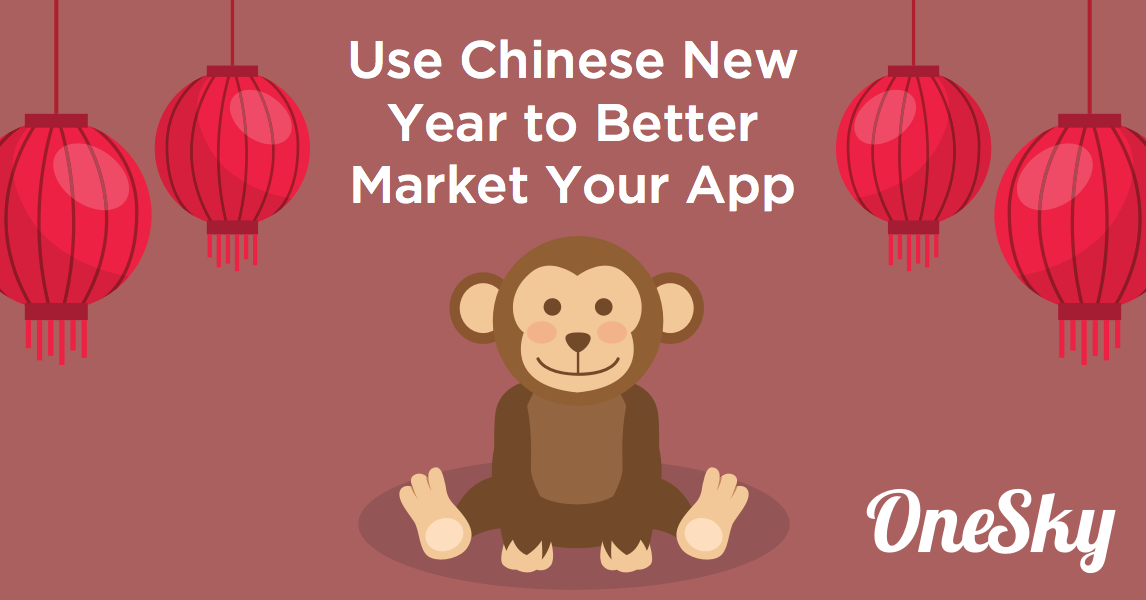
New Year, New Opportunities… in the East
In just a few weeks, there’s going to be a gigantic event: one that tons of people will participate in, that inspires a lot of celebrating, and that has huge potential for retail and advertising.
No, not the Super Bowl. We’re talking about Chinese New Year, a major, week-long event celebrated by the entire Chinese community, beginning on February 7, 2016.
And since the Chinese community numbers over 1.3 billion people, that makes it a pretty big deal. Last Chinese New Year (CNY), the holiday tallied up retail and restaurant sales of RMB 678 billion in mainland China over its seven days. That number converts to US $104.6 billion….or, for context, double the amount spent by Americans on the week of Thanksgiving (and Black Friday!) the year before.
So, how can you make sure that your app benefits from all this excitement? In this blog post, we’ll give you more details about the festival, explain how the Chinese app scene has tapped into CNY celebrations, and share some tips on what you can do to join in on the fun too.
Chinese New Year: The Basics
Who celebrates it?
Chinese New Year–also known as Spring Festival–is celebrated at the turn of the Chinese calendar. It’s seen as a time to honor deities and ancestors.
Since the calendar is lunar, the exact date varies each year, although it usually happens in February; this year, celebrations begin on February 7th, which is the eve of the new year. And, since it is celebrated in pretty much every community, country, and territory with a significant Chinese population, CNY is a worldwide party, with gigantic events in mainland China, Hong Kong, Macau, Taiwan, Singapore, Thailand, Cambodia, Indonesia, Malaysia, the Philippines, and Chinatowns all over the globe.
What do you celebrate with?
As with any good holiday, there are certain symbols and phrases that it’s good to be aware of. The key ones to know for this year are:
- Monkeys. In the traditional Chinese calendar, each year is associated with one of the twelve animals in the Chinese zodiac. This year, it’s the monkey. People go to visit and celebrate live monkeys, and there are lots of monkey-themed decorations!
- Red. It’s the color of the heart, the color of the Chinese national flag…and the color of Chinese New Year. And so, people (literally) paint the town red: windows and doors are decorated with bright paper decorations, and many people wear red clothing.
- Blessings. In Chinese culture, the new year is seen as the time to remove any ill fortune and to welcome in new, good luck. People will often bless their family, friends, and neighbors with messages such as “good fortune,” “health,” “longevity,” and “happiness.”

Chinese New Year decorations with blessings.
…And how do you celebrate?
Family together, a clean house, gifts: you have to start the new year right.
Traditionally, Chinese families gather for an annual reunion dinner, and the new year is seen as the time to thoroughly clean your house. Another notable activity is the giving and receiving of red envelopes full of money, called Hongbao. These symbolize good luck, and are believed to ward off illness and evil spirits in the coming year. Usually, married people give them to single people, with the latter gently requesting the envelopes by wishing blessings on the givers.

Red Envelope
Although the traditions persist, nowadays CNY is also seen more generally as a festival of “happiness.” And happiness often involves spending; according to a 2014 survey conducted by NetEase and 163.com, a third of Chinese people will use their money to go to a party, and 27% will buy clothing or go shopping.
And we’re not talking small amounts. As we mentioned before, there is an enormous Chinese population in the world. Couple that with the rise of the middle class in China, and you have a perfect storm: billions of people who are excited (and willing) to spend–and many who have the money to actually do so.
Case Study: How Tencent Leveraged Chinese New Year to Beat Alibaba
Unsurprisingly, a number of Chinese tech giants realized the huge market potential–and did their best to capitalize on it. But Tencent was the one who did it best. Here’s how:
The Idea: WeChat Red Envelope
On January 17, 2014–right before the beginning of Chinese New Year–Tencent launched an app called “WeChat Red Envelope” (WeChat Hongbao). The app allowed WeChat users to give red envelopes to their friends, relatives, and connections, and to receive them in return.

WeChat Red Envelope
Note that this feature was, in itself, a big step for Tencent: it was their first foray into mobile commerce and payment functionality for WeChat. Before they created the app, they weren’t even a player in this market. Alibaba’s Alipay was dominating the scene.
The Twist: Make it a Game
However, WeChat Red Envelope was not just a way to send and receive gifts. It was also a game. A sender could send envelopes containing various amounts to a circle of friends, with a “first come, first serve” setting. Then, the whole group would get to compete for the red envelope with the highest value. The app started getting some buzz.
Then, in 2015, WeChat partnered with the Spring Festival Gala (a major TV program, airing on the eve of CNY) and introduced another exciting game feature to the mix: the WeChat Red Envelope Shake. During the gala, viewers were invited to shake their smartphones for a chance to win red envelopes. And we’re not talking small change. A total of 1.2 billion red envelopes, worth over half a billion RMB (US $83 million) were sent out during the promotion.

User Interfaces of WeChat Red Envelope Shake
The game hijacked the show. Instead of watching, viewers everywhere began shaking. Some people shook multiple smartphones to increase their chances of winning. Others put all their smartphones and tablets into a sieve, so they could shake them simultaneously. The number of shakes during the gala promotion climbed to 11 billion, with a peak of 810 million per minute.
The Payoff: Instant User Base
Needless to say, the promotion worked. Alipay may have built a strong user base over time and emerged as a market leader, but now Tencent had guaranteed that everyone would know about its mobile payment abilities. Tencent’s seasonal campaign effectively convinced millions of WeChat users to try out their version and, in doing so, built in a month the same size user base as Alibaba had built over years.
Get Your App Ready for CNY
Decorate for the holiday.
We’ve told you the symbols….now use them! Consider incorporating red as a theme color, and don’t forget about those monkeys. (The latter is particularly good if you already have a monkey character in your app or mobile game.)
Not sure where to start? Shutterstock has some good images, that you can use for inspiration–or just use.
Send your users blessings, using push notifications.
But how will your users know that you’ve decorated for the new year? A timely push notification can draw users to your app. Impress them by using a common holiday blessing; to make sure that you’re wording it correctly, ask your local team (or Chinese localizers) to write one for you.
Don’t forget the red envelope.
Learn from Tencent. Capitalize on the red envelope custom.
True, you might not start a nationwide craze. But, by allowing users to send gifts to their friends during CNY, you can monetize your app. Make the option particularly tempting by offering a seasonal discount.
Localize your app into Chinese.
Wait, what? Your app is still only in English? Then forget about getting in on Chinese New Year.
Many Chinese speakers are not comfortable using English, which means localization is crucial for success. We recommend Simplified Chinese, as that will allow the greatest portion of the population to understand your app. And language might not be the only issue; China also has an unusual system of distribution channels, including the almost total absence of Google Play. Read this blog post to learn more.
Not familiar with localization in general? Don’t worry, we have you covered there as well. Start with this guide, and browse our blog for more tips.
Over to You
How are you celebrating Chinese New Year? We’re particularly curious about how you’re using your mobile app or game to do so–but, if you have a personal CNY story to share, we’d love to hear that too. Let us know in the comments below!
From the entire team of OneSky, we wish you 恭喜发财 (Good Luck and Prosperity).



Appreciate it for all your efforts that you have put in this. very interesting info .and waiting for more updates – THOP TV